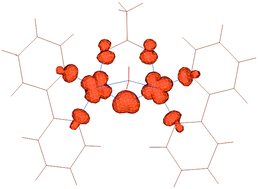Seven new hetero triply-bridged dinuclear Cu(II) compounds have been synthesized and characterized corresponding to a series with general formula [Cu2(L)2(μ-OH)(μ-OH2)(μ-O2CR)]X2 (where L = bpy = 2,2′-bipyridine, 4,4′-dmbpy = 4,4′-dimethyl-2,2′-bipyridine and 5,5′-dmbpy = 5,5′-dimethyl-2,2′-bipyridine; R = H for formate, CH3 for acetate, CH2CH3 for propionate and C(CH3)3 for trimethylacetate and X = CF3SO3− and ClO4−). All compounds exhibit ferromagnetic behavior with the experimental J values derived from magnetic susceptibility measurements being in the 73–104 cm−1 range. The overall qualitative behavior is reproduced by state of the art density functional theory based methods. However, none of the functionals is able to reproduce the fine details along the series which constitutes an excellent benchmark for future developments.
This article is Open Access
 Please wait while we load your content...
Something went wrong. Try again?
Please wait while we load your content...
Something went wrong. Try again?


 Please wait while we load your content...
Please wait while we load your content...